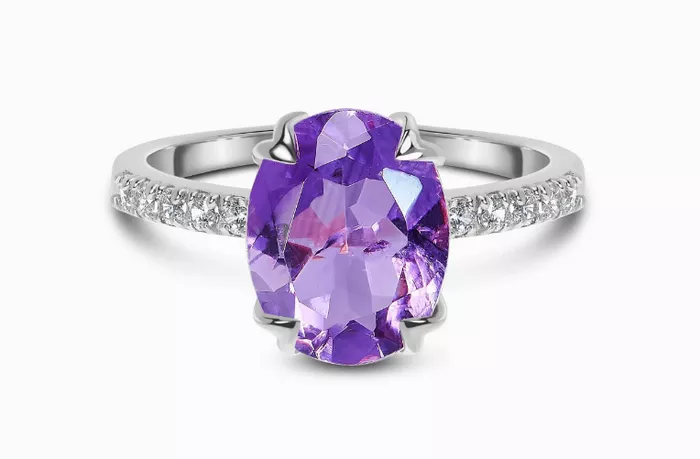Amethyst, with its captivating purple hues, has been cherished for centuries for its beauty and purported metaphysical properties. From ancient civilizations to modern jewelry aficionados, this gemstone has adorned rings, necklaces, and other accessories with its timeless allure. But as with any gemstone jewelry, questions arise regarding its durability and longevity. In this article, we delve into the longevity of amethyst rings, exploring factors that affect their durability and offering tips on how to ensure they last for generations to come.
Understanding Amethyst: A Brief Introduction
Before delving into the longevity of amethyst rings, it’s essential to understand the nature of the gemstone itself. Amethyst belongs to the quartz family and is characterized by its striking purple color, ranging from pale lilac to deep violet. The color is due to the presence of iron impurities and trace elements within the crystal structure.
Amethyst has been revered for its beauty and perceived healing properties throughout history. Ancient Greeks believed it could ward off drunkenness, while medieval Europeans associated it with protection and spiritual enlightenment. Today, it remains a popular choice for jewelry, including rings, earrings, pendants, and bracelets.
Factors Affecting the Longevity of Amethyst Rings
Several factors influence the longevity of amethyst rings, including:
1. Hardness: Amethyst ranks 7 on the Mohs scale of hardness, indicating good durability. However, it is not as hard as diamonds or sapphires, which rank higher on the scale. While amethyst can withstand everyday wear, it is susceptible to scratches and chips if not handled with care.
2. Clarity: The clarity of an amethyst gemstone can affect its durability. Stones with visible inclusions or fractures may be more prone to damage, especially if subjected to impact or pressure.
3. Setting: The way the amethyst is set in the ring can impact its longevity. Secure settings, such as prong or bezel settings, provide better protection for the stone compared to fragile settings like tension or channel settings.
4. Exposure to Chemicals: Amethyst, like other gemstones, can be affected by exposure to harsh chemicals found in household cleaners, perfumes, and cosmetics. These chemicals can cause discoloration or damage to the stone over time.
5. Physical Activities: Engaging in rigorous physical activities while wearing an amethyst ring can increase the risk of damage. It’s advisable to remove jewelry before participating in activities such as sports, gardening, or household chores.
Caring for Your Amethyst Ring
Proper care and maintenance are essential for preserving the beauty and longevity of your amethyst ring. Here are some tips to ensure your ring remains pristine for years to come:
1. Regular Cleaning: Clean your amethyst ring regularly to remove dirt, oils, and debris that can dull its appearance. Use a soft brush or cloth with mild soap and warm water to gently scrub the stone and setting. Avoid using harsh chemicals or abrasive cleaners that can damage the gemstone.
2. Storage: When not wearing your amethyst ring, store it in a jewelry box or pouch to protect it from scratches and impacts. Avoid storing it with other jewelry pieces that may cause friction or damage.
3. Avoid Exposure to Chemicals: Remove your amethyst ring before applying lotions, perfumes, or household cleaners to prevent exposure to harsh chemicals that can tarnish or corrode the metal setting and damage the gemstone.
4. Regular Inspections: Periodically inspect your amethyst ring for any signs of damage, such as loose or missing stones, bent prongs, or scratches. Promptly address any issues by taking your ring to a reputable jeweler for repairs.
5. Professional Cleaning and Maintenance: Consider having your amethyst ring professionally cleaned and inspected by a jeweler at least once a year. A professional cleaning can remove stubborn dirt and grime, while inspections can identify any potential issues before they escalate.
Conclusion
In conclusion, amethyst rings can last for generations with proper care and maintenance. Understanding the factors that affect their longevity, such as hardness, clarity, setting, exposure to chemicals, and physical activities, is essential for preserving their beauty and integrity. By following the tips outlined in this article, you can ensure that your amethyst ring remains a cherished heirloom for years to come.
FAQs
Is amethyst suitable for everyday wear?
While amethyst is relatively durable with a hardness of 7 on the Mohs scale, it is not as tough as diamonds or sapphires. Amethyst rings can withstand everyday wear but should be treated with care to avoid scratches or damage.
How should I clean my amethyst ring?
Clean your amethyst ring regularly with mild soap and warm water using a soft brush or cloth. Avoid using harsh chemicals or abrasive cleaners that can damage the gemstone or metal setting.
Can I wear my amethyst ring while swimming or showering?
It is advisable to remove your amethyst ring before swimming or showering to avoid exposure to chlorinated water or harsh chemicals found in soaps and shampoos, which can damage the gemstone and metal setting over time.
What should I do if my amethyst ring gets scratched or chipped?
If your amethyst ring becomes scratched or chipped, take it to a reputable jeweler for inspection and possible repair. Depending on the extent of the damage, the jeweler may be able to polish out minor scratches or replace the damaged stone.

